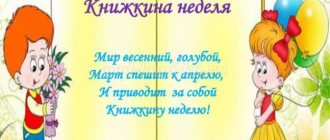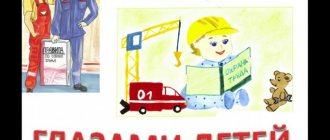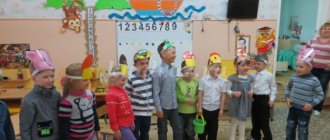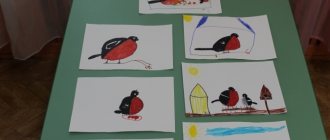“Book Week” in the senior group: planning
It is impossible to overestimate the impact that reading books has on literacy, replenishment of vocabulary, and expansion of a person’s horizons, especially in children at the preparatory stage of development.
“Book Week” at the preschool educational institution
For your information! It is easiest to develop an interest in new things in childhood, since children have the ability to vividly and sincerely experience, sympathize, rejoice, and be indignant, which manifests itself while reading a work of art.
Goals, objectives
The main goal of this project is to instill a love for reading books, teach children to respect them, and develop an interest in books through creative and educational activities.
During the implementation of this project, the following tasks are envisaged:
- To generate and maintain an interest in books and a love of reading, to cultivate a reader's taste and respect for books.
- Give children an idea of the types of books and literary genres.
- Familiarize children with all stages of book creation.
- To develop in children an understanding of the role of the writer, illustrator, and designer in the creation of a book.
- Explain to students the need and importance of libraries.
- Involve children, parents, and teachers in playing out stories from books.
Introducing kids to nature
Lexical topics
Every day of the calendar week it is planned to hold events (games, activities), presentations (speaking out abstracts and publishing notes in class) or thematic classes (communicating important information on a specific topic) on the following lexical topics:
- Monday. A walk around the native land. Acquaintance with nature through the works of writers Bianchi V.V., Prishvin M.M.
- Tuesday. Tanya, Yulechka, Petya and other heroes. Acquaintance with children's poetry through the works of Marshak S. Ya., Mikhalkov S. V., Agnia Barto, Tokmakova I. P., Mustai Karim.
- Wednesday. Travel to Buyan Island. Acquaintance with fairy tales and fables through the works of Pushkin A.S., Krylov I.A., Ushinsky K.D.
- Thursday. Walking around St. Petersburg. Acquaintance with the architecture, geography, life, climate of St. Petersburg through the poems of the poets A. A. Blok, Sasha Cherny.
- Friday. The Adventures of Bibigon. Acquaintance with the works of the writer Chukovsky K.I.
- Saturday. Dunno's friends. Acquaintance with the works of the writer N. N. Nosov.
Additional Information! Within each topic, children should be introduced to the biography and famous works of children's writers and poets, and a general description of their work should be given. Choose one of the plots in the works that most captivated the children, and role-play it with them.
Final event
The final event is that you should set aside time every day to make a book of your own composition and with drawings. At the end of Book Week, there will be an exhibition of books made by the children themselves.
Important! All events within the framework of Book Week must comply with federal state educational standards (FSES).
Logical thinking task for children 5, 6 and 7 years old
Baby book made from A4 paper
Little baby books are great for learning the basics of reading. They are cheerful and funny, there is nothing superfluous in them, and the child perceives such leisure time as an exciting game. And such pocket books are always convenient to take with you on trips and travels!
Photo: pinterest.ru
You will need:
A4 paper, a stationery knife, glue, colored pencils, markers, pens and crayons.
How to do:
Fold a sheet of A4 paper in half lengthwise, then again crosswise, and again each half. Unfold it and make a cut in the middle with a utility knife. Coat one side with glue along the entire plane and fold the book, fixing the pages.
You can combine several of these paper blocks into one thicker book and even make a cover. All that remains is to draw pictures and write text. They can be used to study the seasons, animals, surrounding objects, numbers - anything!
Bibliography:
- Convention on the Rights of the Child: UN Convention. – M.: RIOR, 2007.
- Myachina L.K., Zotova L.M., Danilova O.A. “Little children have great rights”: Educational and methodological manual. SPb.: CHILDREN'S PRESS, 2010.
- Myachina L.K., Zotova L.M., Danilova O.A. My rights: Workbook for the teaching aid “Little children have great rights.” SPb.: CHILDREN'S PRESS, 2010.
- Shorygina T.A. Conversations about children's rights. — Methodological manual for classes with children 5–10 years old. – M.: TC Sfera, 2008.
Making a baby book with your child
Sometimes children even get bored with cute felt bunnies and rattles, but they love to create and come up with new ideas themselves. Choose a theme for a baby book together, draw, collect interesting facts, use pictures and stickers!
Photo: connecticum-dou.ru
You will need:
Paper, glue, paints and pencils, old magazines and printouts, stickers, needle and thread.
How to do:
Instead of making fabric pages or printing out backgrounds, design them yourself! For example, to make a book about animals, first draw their habitats. To do this, fold sheets of A4 paper in half and hand them to your child along with the pictures - let the child choose the animals he wants to live there, while you find something interesting about them.
Older children can fill out the text in the baby book themselves - at the same time this will be a short training in their writing skills. All that remains is to stick all the animals onto your pages and sew the book in the middle with regular thick thread.
Did you like the post? Subscribe to our channel in Yandex.Zen, it really helps us in our development!
Appendix No. 2
First level:
- What is the name of the main document on the rights of the child adopted at the 44th session of the UN General Assembly? (Convention on the Rights of the Child)
- In what year was the Convention on the Rights of the Child adopted? (1989)
- How many articles does the Convention on the Rights of the Child include? (54)
- In what year did Russia ratify the Convention on the Rights of the Child? (1990)
- In what year was the Universal Declaration of Human Rights adopted? (1948)
- At what age is a person considered a child, according to the UN? (0-18 years)
- To whom does the Convention give primary responsibility for raising a child? (for parents)
- Name the Polish writer who published the book “The Child’s Right to Respect” in 1929? (Janusz Korczak)
- Is raising a child a right or a responsibility of parents? (Both right and duty)
- Who owns the words that “the happiness of the whole world is not worth one tear on the cheek of an innocent child”? (F.M. Dostoevsky)
- Who is responsible for raising a child if the parents divorce? (Both parents)
Second level:
- Why did the inhabitants of the courtyard in Andersen's fairy tale "The Ugly Duckling" offend the ugly duckling? (He was not like the others.)
- Who violated the right to inviolability of home in the fairy tale “Zayushkina’s Hut”, and who helped the hare restore his rights? (Fox, Rooster)
- How far could the frog move using its right to freedom of movement? (No limits)
- What crime did the geese-swans commit in the fairy tale of the same name by stealing their brother? (Child abduction)
- What are the fairy tales in which the right to work was violated? (“Cinderella”, “Moroz Ivanovich”, “Thumbelina”)
- Do you think a child has a right to his opinion? (Yes, sure)
- What is the name of the profession of a person who exercises the right to medical care? (Doctor)
- What do you know about your name? (Name designation and translation)
- In which fairy tales is the right to privacy of home violated? Name them. (“Three Bears”, “Three Little Pigs”, “Zayushkina’s Hut”, “Little Red Riding Hood”)
- Name the correct fairy tale in which a talking cricket invites Pinocchio to exercise his right to education? (The Golden Key or The Adventures of Pinocchio)
Third level:
- Determine what rights were violated in the following cases: a child was given contaminated blood in a hospital. (Right to life, art. 6)
- The neighbor on the desk read a note addressed to another student. (Right to privacy of correspondence)
- What right did the witch violate in the fairy tale “Sister Alyonushka and Brother Ivanushka”? (The right to live)
- What right did the animals violate in the fairy tale “Kolobok” when they tried to eat the main character of the fairy tale? (The right to live)
- What right was violated by the Wolf in the fairy tale “Little Red Riding Hood” in relation to the grandmother (Right to life and right to inviolability of home). What about Little Red Riding Hood? (The right to live)
- What right was violated in the fairy tale “Zayushkina’s Hut”? (Right to inviolability of home)
- What rights did the brothers violate in the fairy tale “Ivan Tsarevich and the Gray Wolf”? (The right to live)
- What right did the talking Cricket advise Pinocchio to exercise in A. Tolstoy’s fairy tale “The Golden Key”? (Right to education)
- What right did Buratino violate by grabbing the rat Shushera by the tail? (The right to live)
- Why can't you give your comrades nicknames? (The right to the name is violated)
Baby book on rings
Tactile sensations are the most important life stage for all children, so baby books need appropriate ones. Use large details, expressive textures, bright colors and different materials. Connect individual pages into large rings or ties.
Photo: cdo21.ru
You will need:
Colored cardboard, scissors, hole punch and rings, glue, stapler, colored fabric, all kinds of fillers and tape.
How to do:
Fold a sheet of cardboard in half, glue it and use a hole punch to make holes in the middle for stitching - these will be your pages. Later you can assemble them onto split rings. This way the baby book will be convenient to store, nothing will get lost, but the child will be able to study each sheet separately.
Glue bubble wrap, lace, corrugated paper or some other material with an unusual texture onto double-sided tape. Use tassels, fringe, small knitted toys and decorations, balloons, ribbons, pom-poms, feathers - whatever you find!
Baby book made of fabric
Soft baby books with fabric pages are sold in huge numbers in children's stores. But why overpay for something you can easily and quickly do with your own hands? It is enough to master the basic principle - and you will be able to make such toys until your child gets tired of it!
Photo: pinterest.com.au
You will need:
Multi-colored fabric, ribbons, lace, felt, large textured details, threads and needles.
How to do:
Cut out several pieces of multi-colored fabric 20x40 cm (or whatever size pages you want). Decorate them with letters or felt pieces, Velcro figures, zippers, buttons, fur, feathers, tassels, laces, fringes and knitted toys.
To join the pages, place two of them face to face, stitching around the perimeter and leaving only a small hole on one side. Through it, carefully turn the workpiece inside and put a piece of thin padding polyester inside for volume, and then sew up the hole. This will be the cover, first and last pages, respectively.
Simply fold all the inner pages in half, sew them together, turn them inside out and fill them with padding polyester in the same way. The inner pages are simply sewn inside with large stitches or attached to tape. Make ties or fasteners on the cover to make it more interesting for the child and more convenient for you.



